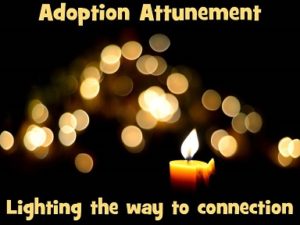
All healthy parents care about and attend to their children’s academic and emotional needs. That is a given. Adoptive parents are called to an additional level of education: that of mastering parenting that is infused with adoption-sensitivity.
On this blog, we refer to AQ frequently. As National Adoption Month approaches we thought it made sense to elaborate on each of the specific AQ elements. AQ (Adoption-attunement Quotient) considers how adoption influences a child and includes:
Adoption-sensitive parenting techniques— Parenting techniques–like Time Out— considered the “norm” work well for families with children who haven’t faced the trauma of separation, abuse or neglect. But such strategies can be ineffective, even damaging to adopted children. When we work so hard to build connection and attachment, punishing kids with isolation and creating insecurity about the parent/child relationship is not wise.
Instead AQ parents choose Time In which focuses on “connecting before correcting” a technique advocated by Dr. Karen Purvis. Time In focuses on strengthening the relationship, on helping the dysregulated child become regulated and on establishing an experience of perceived safety. After the child becomes regulated, then he will be able to examine his missteps, to listen to parental input, and to extract any learning.
Another popular behavior management tool, reward systems and charts often backfire or are largely ineffective–especially for kids with trauma histories. Whether it is the pressure of being “good enough” or self limiting beliefs that expect failure or their unwillingness to participate because they need to be in control–any or all of these factors could contribute to the low response rate with kids who had “tough starts.”
Sound adoption language— Language infused with respect best serves all parties in the adoption triad (adoptee, adoptive parents and birth/first parents.) Choose words that are accurate and reflect the realities of the adoption experience. This is a step beyond “positive” adoption language which can slide into minimizing. The actual vocabulary changes as we better understand the complexities and sensitivities of each. Think it through by imagining yourself as a birth parent or adoptee. How does the term touch your ears and heart now?
Consider “Gotcha Day,” a term that celebrates a child’s arrival in the adoptive family. While the intent of this unfortunate term is positive, the reality is a bit off the mark. First, it focuses on the parental experience instead of the child’s. Second, “gotcha” is often a term used to indicate victory over another person. Third, it objectifies the child, like a prized toy that was finally acquired. “Arrival Day, Homecoming, Family Day are better choices. Be mindful however, that there are two sides to this special day: the happy part about joining a permanent family, and the sad part –losing the family to which he was born. Be prepared for your child to show very mixed emotions.Read more
Knowledge of the attachment process Attachment is a dance of action and response. A parent’s own attachment style will influence how he/she interacts with each child. By understanding one’s own inclinations, a parent can modify this feedback loop to be more responsive to their child’s attachment style. Responding accurately, promptly and consistently to your child’s overtures sends many important messages:
- You are listening.
- He’s important and worth your time and attention.
- You value what he feels, thinks, and says.
- She is capable of asking for what she needs.
- It is appropriate for him to speak up for himself.
- She can count on you to listen and respond.
- When you respond with empathy, she learns to do the same.
Consideration of grief and loss issues— As parents we celebrate the great blessing of welcoming our children into our families. The reality for our children, however also includes very real losses as well. Their separation from their birth families is a significant source of grief and pain. The two realities–adoptive family/birth family–coexist; they do not cancel out one another. Each is important to the child. Each is an integral, valuable, and permanent part of them.
Respect for birth parents–A fundamental tenet of adoption. Our children are the fruit of their birth parents. When we honor and respect birth parents, we honor and respect our children. In cases where abuse and neglect occurred, it is essential to separate the individuals from their actions. Find some way to demonstrate to your child that there is always a kernel of goodness that can be acknowledged–even if the it is only that they created your child.
Next week, we will explore the remaining concepts of AQ
- Model healthy boundaries
- Educate family, friends and teachers on adoption
- Remember that a child’s story belongs to him
- Recognize that adoption is a family experience
- Encourage playfulness and good humor as a family value
- Integrate a child’s birth heritage
- Adoptive Parents handle their own grief and loss issues.
Learn how the coaches at GIFT Family Services can help you and your family navigate your adoption journey. We’ve faced our share of family challenges and crises, ridden the metaphorical rollercoaster, and our families have not only survived; they have thrived. We offer experience, neutrality, and understanding.

Read Adoption-attuned book reviews
by GIFT coach, Gayle H. Swift, on her blog,
“Writing to Connect”



